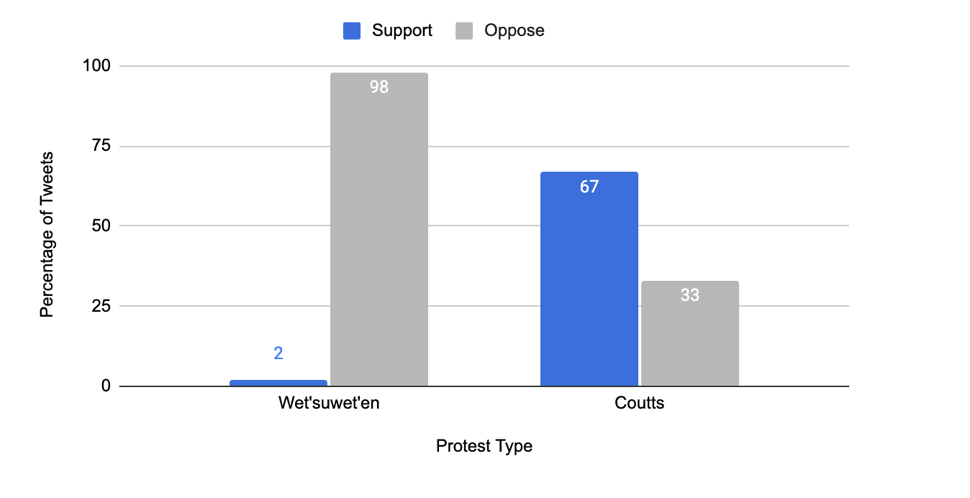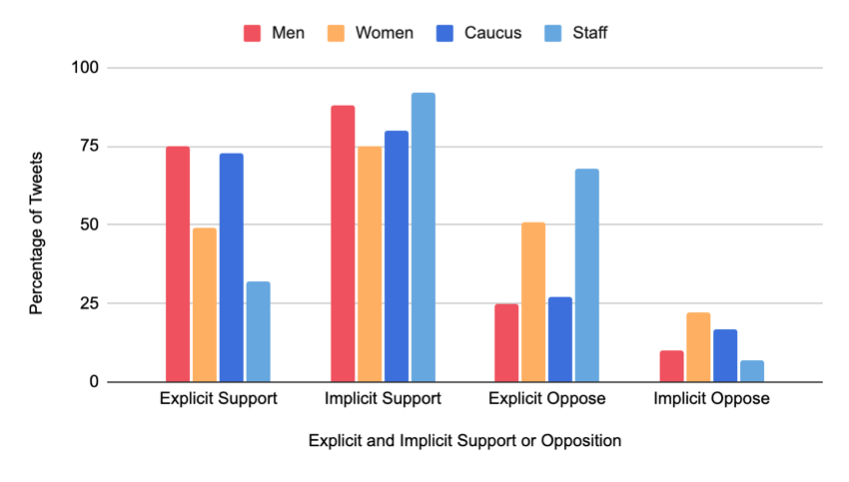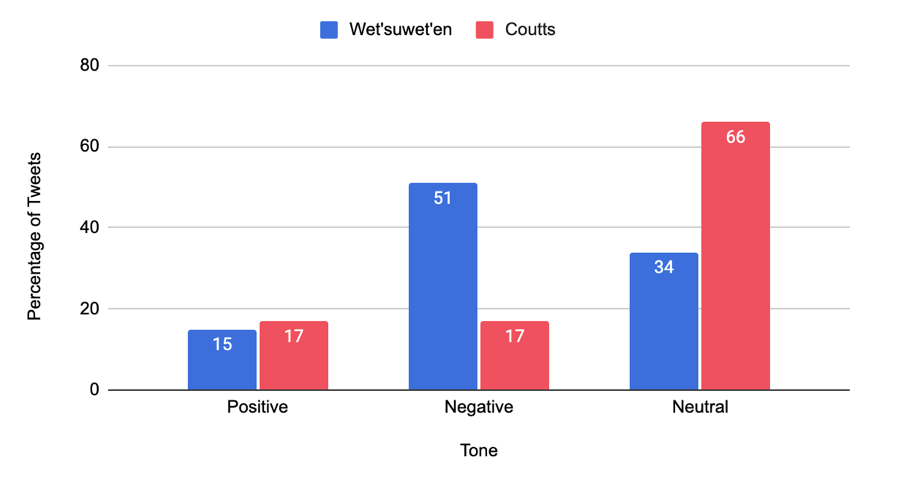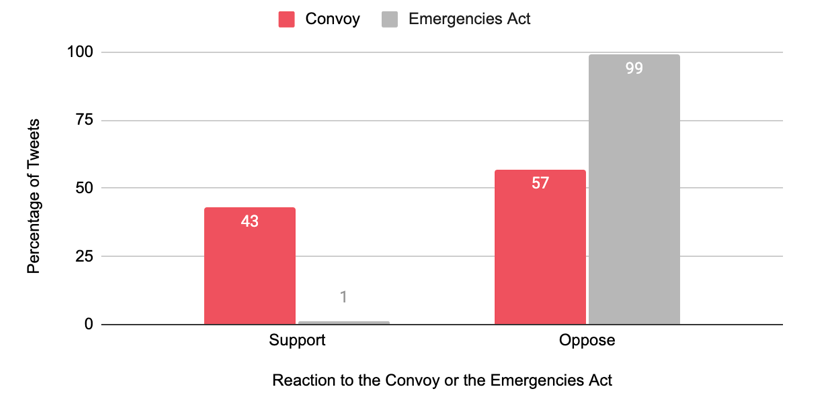Analyzing the Alberta Government’s Response to Protest Blockades
Kiera Fischer | University of Alberta | cgroundpolitics@gmail.com
Background
The Wet’suwet’en Railway Blockades began as solidarity protests with the hereditary chiefs of the Wet’suwet’en First Nation who openly opposed the Coastal GasLink pipeline because its proposed path ran through their ancestral, unceded land in northern British Columbia (Staff 2022). From February 6 to 23, 2020, protesters blockaded railways across Canada in solidarity with the hereditary chiefs (Staff 2022). In Edmonton, Alberta, a solidarity railway blockade was erected and dismantled by counter-protesters within a day; however, in response to the brief blockade, Alberta’s government developed Bill 1, the CIDA, which set out heavier penalties for protesters who blocked critical infrastructure (Staff 2022).
The CIDA was not invoked by law enforcement during the Coutts border blockade that disrupted one of Western Canada’s busiest international border crossings for 18 days in 2022 (Gervais 2022). The Coutts border blockade was a branch off of the Freedom Convoy, in which people from across Canada travelled to Ottawa to protest mandatory vaccinations for cross-border truckers between the U.S. and Canada, COVID-19 restrictions, and the Liberal government (Westfall 2022). Over the duration of the Freedom Convoy and Coutts blockade, it became evident that protesters’ demands targeted the end of all remaining COVID-19 restrictions, rather than only those associated with truckers. Within days of the beginning of the border blockade, the Government of Alberta announced that the restrictions exemption program, that limited certain activities to those who had received their COVID-19 vaccinations, would end and that many other health restrictions would be lifted in a timely manner (CBC News 2022).
The following analysis builds upon a collection of 1221 tweets from 32 government caucus and staff accounts. Over half (56%) of the tweets collected were associated with the Wet’suwet’en protests and 45% were associated with Coutts; these percentages include 5 tweets that referenced both protests. The time frame for tweets that were considered relevant to the Wet’suwet’en protests spanned from January 1, 2020, to March 31, 2020, and those relevant to Coutts were from January 1, 2022, to March 31, 2022.
September 2022
Findings
Explicit and Implicit Protest Support
A key finding in the data from the URI project was the difference in explicit and implicit government support of a protest. Explicit support was coded based on the expression of support or opposition towards a protest when it was clearly mentioned in the tweet. The following tweet is an example of a post that was coded as being in explicit opposition to Wet’suwet’en: “Interesting piece here about some of the faces behind recent infrastructure blockades in BC. What’s clear? This is a purely anti-corporate, anti-development agenda that has nothing to do w/ #environment or #indigenous rights. #AbLeg #cdnpoli” (@JasonNixonAB, February 27, 2020). Figures 1 and 2 show explicit support for the protest and protesters, as both were coded separately. Implicit support and opposition were revealed by asking whether the type of government action identified in the post supported the demands or suggestions of the protest or protesters. An example of implicit support would be: “Ottawa’s trucker vaccine mandate has to go. We are at the peak of supply chain constraints with empty shelves popping up all over the country. We can't afford to lose thousands of truckers” (@jkenney, January 22, 2022). Figure 3 shows the implicit reaction to both the protest and protesters, as they were coded together under “government action in response to protest demands.”
Figure 1. Percentage of Tweets by Explicit Reaction to Protests
Source: URI student project.
Figure 2. Percentage of Tweets by Explicit Reaction to Protesters
Source: URI Student Project.
Figures 1 and 2 focus on explicit reactions to the protest and to the protesters of both blockades. The government clearly chose to oppose the Wet’suwet’en blockade. Conversely, the difference between the number of Coutts tweets that expressed support versus opposition was noticeably smaller. This suggests greater inconsistency in the government’s messaging on the Coutts blockade and implies that the response could lead to various interpretations of the government’s position. Below, Figure 3 displays the findings for implicit support or opposition. It shows that when the government’s response was inherently less clear, or implicit, the support for the Coutts protest and protesters was far clearer. Whereas it was evident both implicitly and explicitly that the government did not support the Wet’suwet’en blockade, the extent of government support for the Coutts blockade is difficult to decipher from their Twitter responses.
Figure 3. Percentage of Tweets by Government Action in Response to Protest Demands
Source: URI Student Project. The percentages in the above graph do not sum to 100% as the responses that were neutral and both supported and opposed the protest were not included in figure 3 as they were very minimal fractions and are less relevant than support and oppose.
The data pulled from the collection of tweets was split into the subsets of gender and government position. Figure 4 shows the explicit and implicit protest support or opposition of men, women, caucus members, and government staff. In figure 4, it is evident that men and government caucus members were more likely to explicitly support the Coutts protest than women and government staff. Government staff accounts had the highest levels of implicit support of the Coutts blockade.
Figure 4. Explicit and Implicit Reactions to Coutts Blockade, by Tweet Author
Source: URI student project. The percentages in columns above “implicit support” and “implicit oppose” in figure 4 will not add up to 100% as the responses that were neutral and both supported and opposed the protest were not included because they were very minimal fractions and are less relevant than support and oppose.
Further Response Differentiation
Following the initial determination of support, the tweets were evaluated based on tone. Tone was coded as positive, negative, or neutral. Word choice was the main deciding factor of tone, but consideration was also given to literary devices like sarcasm and punctuation like the exclamation mark. An example of a positive tweet would be: “Inspiring to see members of the Wet'suwet'en community like Bonnie George speak out against the intimidation & mob tactics being used by @CoastalGasLink opponents. ‘I will not jeopardize or dishonour (my) integrity” (@jkenney, February 12, 2022). The following is a post that was coded for negative tone: “The NDP used to be principled defenders of civil liberties. Sad to see that today’s NDP are apologists for the disproportionate & unnecessary use of emergency powers” (@jkenney, February 18, 2022). It is important to note: a tweet with negative tone does not necessarily involve opposition to a given protest.
Figure 5. Percentage of Tweets by Tone
Source: URI student project.
Figure 5 shows that for both Wet’suwet’en and Coutts, posts were more frequently coded for the use of a negative tone over a positive one. Most tweets related to the Coutts blockade were neutral, which coincides with the government’s undecided stance on this protest. Compared to the aggregate data set, the tone of women’s and caucus members' Wet’suwet’en posts displayed higher percentages of positivity and neutrality and those of men and government staff, which had higher percentages of negativity.
A likely contributor to the higher percentage of negative tone used in tweets related to the Wet’suwet’en protest was the use of derogatory words to describe protesters. Derogatory words were identified in terms of whether the author had meant the word to cast the protester negatively. Unsurprisingly, words like “extremist, terrorist, radical activist or left-wing militants,” were coded as derogatory, but so were less assuming labels like “leftist, mob rule, blockader, and professional protesters.”
Figure 6. Percentage of Tweets by Presence of Terms
Source: URI student project.
The first section of figure 6 shows that all of the derogatory words in the collected tweets were used to describe Wet’suwet’en protesters. The use of derogatory terms serves to discredit the protesters. It is clear that the government was willing to demean Wet’suwet’en protesters, but not Coutts protesters. This is evidence that the government treated citizens who were engaged in a similar type of protest differently based on which protest they participated in.
Delving deeper into the importance of word choice for framing a protest, the second set of columns in figure 5 displays the use of the words “blockade, blockades, or blockading” in a post. The inclusion of the terms blockade(s) or blockading was relevant to how the government framed the protest. “Blockade” tends to refer to the consequences on critical infrastructure and the economy more clearly than “situation” or “protest.” Whereas 24% of Wet’suwet’en posts used the term, only 11% of Coutts posts did (Figure 6). The third set of columns in figure 6 also supports this finding, as the protest’s effect on the economy was mentioned more often in Wet’suwet’en posts, though both protests had very large implications on the economy.
Framing the Protests
The analysis of the URI project data has revealed that a significant difference in the Alberta government’s protest response was due to the framing of the protests to fit the United Conservative Party’s agenda.
Figure 7 breaks down the mention of specific topics that were related to the Wet’suwet’en blockades.
Figure 7. Percentage of Wet’suwet’en Tweets by Mention of Topics
Source: URI student project.
Figure 7 shows that despite Indigenous land defense being the concern of the Wet’suwet’en hereditary chiefs, it was only mentioned in 2% of the Wet’suwet’en posts. Mentioned significantly more often were non-Indigenous protesters, which included environmentalists and anti-development activists, support for oil and gas, and the positive association between Indigenous people and industry and resources.
The presence of resource support and mention of environmentalism in the Wet’suwet’en tweets suggests that the government attempted to shift focus away from the role of Indigenous land defense and towards the presence of anti-pipeline in the protests. Additionally, the government’s mention of the positive association between Indigenous people and resources or industry more than land defense conveys the message that most Indigenous people supported the Coastal GasLink Pipeline.
The government’s approach to the Coutts blockade was less focused on the framing of the protest and more on attempting to balance the acknowledgment of the blockades’ illegality and its detriment on the economy with trying to assuage the protesters. Figure 8 shows that over half (58%) of Coutts tweets mentioned dropping COVID-19 restrictions, and nearly one-fifth (19%) discussed the federal Emergencies Act. Interestingly, the convoy was only mentioned in 4% of Coutts tweets, suggesting the possibility that the UCP was seeking to separate the main convoy movement -- which has more support among Albertans -- from the less popular Coutts border blockade. Figure 9 supports this argument, as it shows that the level of support for the Freedom Convoy, in which protesters targeted the same issues as those at the Coutts border blockade, was similar to the level of opposition. The government clearly opposed the invocation of the federal Emergencies Act, which targeted protesters of the Convoy in Ottawa and the blockade at Coutts, displaying the pattern of supporting the protesters through action rather than through words via social media.
Figure 8. Percentage of Coutts Tweets by Mention of Topics
Source: URI student project.
Figure 9. Percentage of Coutts Tweets by Reaction to the Convoy and use of the Emergencies Act
Source: URI student Project.
It is additionally useful to note that the April 2022 Viewpoint Alberta Survey found that only 16% of convoy supporters and just over 20% of convoy non-sympathizers responded that they checked Twitter “every day” or “a few times a week” (Wesley 2022, 23). In comparison, 40% of convoy supporters and nearly 45% of convoy non-sympathizers checked Facebook “every day” or “a few times a week” (Wesley 2022, 23). The survey data suggests that convoy supporters were likely not the main audience of the government’s tweets on the Coutts blockade. The anticipated audience may explain why the government choose to take an undecided approach to explicit support of the protesters and protest but appeared to be more definitive in its implicit support, as the government’s position could have been deliberately unclear.
Government’s Response vs. Albertans’ Support
A prevalent trend running through the URI project data was that the government opposed the Wet’suwet’en blockades and protesters, and less obviously supported the Coutts protesters but disagreed with the blockade. The April 2022 Viewpoint Alberta Survey asked Albertans to rate their support or opposition with “Wet’suwet’en anti-pipeline protesters” and “protesters who shut the border at Coutts” on a scale from 0 (strongly oppose) to 10 (strongly support) (Wesley 2022, 12). Figure 10 shows that Albertans more strongly opposed the Coutts protesters than the Wet’suwet’en protesters (Wesley 2022, 12).
The survey’s findings display a gap between Albertans’ support for different protests and the Alberta government’s support for those protests as expressed through Twitter. Not only did the government’s protest response reveal a willingness to treat active citizens differently based on group affiliation, but it also showed a willingness to present a narrative that was not representative of Albertans’ perspectives. Through its Twitter protest response, the UCP government showed that it would use protests to push its own agenda, rather than to respond to the requests of citizens.
Figure 10: Albertans’ Support for Various Protester Groups
Source: April 2022 Viewpoint Alberta Survey. Figures represent averages based on the question: “On a scale from 0 to 10, where 0 is strongly oppose and 10 is strongly support, how do you feel about the following groups?”
Conclusion
Based on the findings from the URI research project, the Alberta government’s Twitter response to the Wet’suwet’en and Coutts blockades differed in terms of explicit and implicit support, tone, use of derogatory words and forms of the word “blockade,” and mention of the effect on the economy. This difference arises despite the protests’ common ground of blocking critical economic infrastructure to gain attention for their causes. In shifting the narrative of the Wet’suwet’en protests away from Indigenous land defense and towards support for oil and gas, it is likely that the government was able to use the publicity of the protest to further its pro-pipeline agenda. Similarly, with the Coutts protest, the government was able to capitalize on the demand to reduce COVID-19 restrictions and drop the restrictions exemption program that it had been hesitant to enforce from the beginning of its implementation (Kost 2021).
The government’s approach to supporting the protests was found to be the opposite of what Albertans identified in the April 2022 Viewpoint Alberta Survey. As protesting citizens were treated differently based on which type of protest they were involved with, and the views of Albertans were not reflected in the government’s protest response, it is apparent that the government used protests to further its political agenda, rather than respond to its citizens.
Looking forward, future protest response from the UCP government is likely to remain inconsistent. This makes it difficult for protesters to understand what the potential consequences of their actions may be when engaging in protests. Differential treatment may also serve to deepen divisions between groups, as has already been seen with the criticism from First Nations that the response to Coutts revealed a “discriminatory double standard” in handling protests (Anderson 2022).
Methodology
The Undergraduate Research Initiative (URI) student research project was conducted between May 1 and August 17, 2022. It consisted of 1 221 tweets collected from the Twitter accounts of caucus members, government staff, and the United Conservative Party (UCP). The tweets were human-coded by a group of 4 students based on a codebook created by the project owner with an inter-coder reliability percentage of 70%. Kiera Fischer, the URI stipend recipient and lead coder was assisted by Runo Confidence Obewho, Abel Zeleke, and Denzel Sibanda, who were hired to work under the research supervisor, Dr. Jared Wesley, as part of the Black Youth Leadership and Mentorship Program. Following this coding, the percentages were calculated using Stata. This research project was funded by the Undergraduate Research Initiative at the University of Alberta.
The April 2022 Viewpoint Alberta Survey was distributed online by Pollara between April 8 and May 4, 2022. The following link contains a copy of the survey questions: https://bit.ly/3LelxQi. Pollara uses an online panel system to ensure that registered panelists meet the survey’s demographic criteria. The data is based on a collection of 2151 responses with an average completion time of 15 minutes. The aggregate data set was split to allow for the calculation of certain survey questions. The co-principal investigators of the Viewpoint Alberta survey were Michelle Maroto, Feodor Snagovsky, Jared Wesley, and Lisa Young and it was partially funded by the Kule Institute for Advanced Study (KIAS) at the University of Alberta.
Works Cited
Anderson, Drew. 2022. “Alberta’s response to Coutts blockade proof of discriminatory double standard, First Nations say.” The Narwhal, February 4, 2022. https://thenarwhal.ca/coutts-border-blockade/.
CBC News. 2022. “Alberta lifts COVID-19 measures, with restrictions exemption program now over.” CBC News, February 8, 2022. https://www.cbc.ca/news/canada/edmonton/covid-alta-edmonton-kenney-1.6343576#:~:text=CBC%20News%20Loaded-,Alberta%20lifts%20COVID%2D19%20measures%2C%20with%20restrictions%20exemption%20program%20now,or%20sit%20at%20entertainment%20venues..
Gervais, Brittany. 2022. “Sounding their horns, protesters roll out of Coutts after 18-day blockade.” Calgary Herald, February 15, 2022. https://calgaryherald.com/news/local-news/alberta-border-reopens-as-protesters-leave-blockade-after-18-days.
Government of Alberta. 2022. “Protecting Critical Infrastructure.” Alberta. https://www.alberta.ca/protecting-critical-infrastructure.aspx.
Kenney, Jason (@jkenney). 2020. “Inspiring to see members of the Wet'suwet'en community like Bonnie George speak out against the intimidation & mob tactics being used by @CoastalGasLink opponents. ‘I will not jeopardize or dishonour (my) integrity.’” Twitter post, February 12, 2020. https://twitter.com/jkenney/status/1227799004559241217.
Kenney, Jason @jkenney). 2022. “Ottawa’s trucker vaccine mandate has to go. We are at the peak of supply chain constraints with empty shelves popping up all over the country. We can't afford to lose thousands of truckers.” Twitter post, January 22, 2022. https://twitter.com/jkenney/status/1484925402002989062.
Kenney, Jason (@jkenney). 2022. “The NDP used to be principled defenders of civil liberties. Sad to see that today’s NDP are apologists for the disproportionate & unnecessary use of emergency powers.” Twitter post, February 18, 2022. https://twitter.com/jkenney/status/1494768716805861377.
Kost, Hannah. 2021. “What we know about Alberta's new vaccine passport (that's not being called a passport) so far.” CBC News, September 16, 2021. https://www.cbc.ca/news/canada/calgary/alberta-vaccine-passport-restriction-exemption-program-covid-1.6178020.
Nixon, Jason (@JasonNixonAB). 2020. “Interesting piece here about some of the faces behind recent infrastructure blockades in BC. What’s clear? This is a purely anti-corporate, anti-development agenda that has nothing to do w/ #environment or #indigenous rights. #AbLeg #cdnpoli.” Twitter post, February 27, 2020. https://twitter.com/JasonNixonAB/status/1233024548875816960.
Staff. 2022. “Timeline of Wet’suwet’en solidarity protests and the dispute that sparked them.” Global News, August 24, 2022. https://globalnews.ca/news/6560125/timeline-wetsuweten-pipeline-protests/.
Tran, Paula. 2022. “Comparing Coutts border protest to Indigenous land defenders inaccurate, says Alberta premier.” Global News, February 9, 2022. https://globalnews.ca/news/8606544/alberta-premier-coutts-border-protest-indigenous-land-defenders/.
Wesley, Jared. 2022. “Alberta Separatism and the Freedom Convoy: A New Brand of Western Alienation.” Paper for the Public Order Emergency Commission. August 2022.
Westfall, Sammy. 2022. “Here’s what you need to know about the ‘Freedom Convoy’ in Canada.” The Washington Post, February 7, 2022. https://www.washingtonpost.com/world/2022/02/07/freedom-convoy-ottawa-canada-vaccine/.










